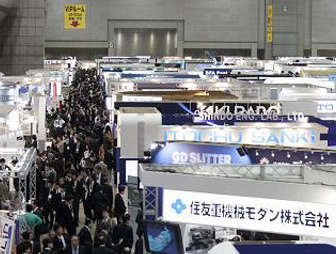
Sony Showcases 21-inch OLED, 3D LCD Prototypes at Display 2009
Sony showcases its latest 3D and 21" OLED display prototypes for the first time in Japan at the FPD trade show "Display 2009", which is held at Tokyo Big Sight, Japan on April 15-17.
Sony's approach to the entertainment enabled by 3D technologies includes the introduction of the company's first 3D display prototype. The HD panel, which first appeared at the CES show in Las Vegas earlier this year, uses parallax barrier to divide light so different images reach the viewer's left and right eyes. The brain naturally interprets the image disparity so a user centered in front of the screen sees a realistic 3D visualization of complex geometry, using special glasses.
Sony also showcased two new OLED display prototypes. The 21" OLED panel supports a resolution of 1,366x768, a contrast ratio of 1,000,000:1 and its just 1.4mm thick. OLED TV prototypes using this panel had a thickness of about 1cm.

Sony's second prototype is an ultra-thin (0.3mm thickness) OLED display. The panels can display content at 960x540 and are actually based on the structure of Sony's first commercially available OLED panel, the XEL-1. However, Sony has managed to slim down the panel at just 0.3mm by greatly reducing the thickness of the glass substrate where the luminous layer and the TFT substrate are placed.
Sony's booth also included the new BRAVIA W5 Series of LCD TVs featuring the company's proprietary "Motionflow 240Hz" technology "Motionflow 240Hz", as well as the BRAVIA V5 Series of LCD TVs, which offer substantial power savings thanks to the newly developed backlight technology that reduces power consumption by 40%, along with a zero-watt standby power switch.
At the same event, Toshiba Matshushita Display Technologies showcased an "Integral Imaging 3D Display" prototype, which is a 3D stereoscopic display. TMD has integrated an advanced 3D film with the display that use Optically Compensated Bend (OCB) mode to deliver a stereoscopic viewing at a glance, without the need for special glasses.

Finally, NEC LCD Technologies Ltd. is exhibiting a high-density three-dimensional LCD module enabling naked eye viewing of stereoscopic images featuring NEC's proprietary HDDP (Horizontally Double-Density Pixels) structure. In standard LCDs, the typical pixel shape is square, with the RGB sub-pixels distributed in vertical stripes. with conventional LCD layout, two pixels are needed to show a 3D display, which ends up sacrificing the horizontal resolution by half. With NEC's HDDP structure, RGB sub-pixels are rotated 90 degrees and divided in half to get double-density resolution. If the information displayed for each eye is slightly different then the image is perceived as 3D. However, if the same information is displayed for both the right and the left eye, the image is displayed in 2D. NEC's 12.1" and a 3.1" LCD modules showcased at the event are capable of displaying both 3D and 2D content. The displays offer 16.77 million colors and contrasts of 500:1. The 12.1-inch prototype has a resolution of 800x600 pixels. NEC plans to offer such displays in the end of the year.

Sony also showcased two new OLED display prototypes. The 21" OLED panel supports a resolution of 1,366x768, a contrast ratio of 1,000,000:1 and its just 1.4mm thick. OLED TV prototypes using this panel had a thickness of about 1cm.

Sony's second prototype is an ultra-thin (0.3mm thickness) OLED display. The panels can display content at 960x540 and are actually based on the structure of Sony's first commercially available OLED panel, the XEL-1. However, Sony has managed to slim down the panel at just 0.3mm by greatly reducing the thickness of the glass substrate where the luminous layer and the TFT substrate are placed.
Sony's booth also included the new BRAVIA W5 Series of LCD TVs featuring the company's proprietary "Motionflow 240Hz" technology "Motionflow 240Hz", as well as the BRAVIA V5 Series of LCD TVs, which offer substantial power savings thanks to the newly developed backlight technology that reduces power consumption by 40%, along with a zero-watt standby power switch.
At the same event, Toshiba Matshushita Display Technologies showcased an "Integral Imaging 3D Display" prototype, which is a 3D stereoscopic display. TMD has integrated an advanced 3D film with the display that use Optically Compensated Bend (OCB) mode to deliver a stereoscopic viewing at a glance, without the need for special glasses.

Finally, NEC LCD Technologies Ltd. is exhibiting a high-density three-dimensional LCD module enabling naked eye viewing of stereoscopic images featuring NEC's proprietary HDDP (Horizontally Double-Density Pixels) structure. In standard LCDs, the typical pixel shape is square, with the RGB sub-pixels distributed in vertical stripes. with conventional LCD layout, two pixels are needed to show a 3D display, which ends up sacrificing the horizontal resolution by half. With NEC's HDDP structure, RGB sub-pixels are rotated 90 degrees and divided in half to get double-density resolution. If the information displayed for each eye is slightly different then the image is perceived as 3D. However, if the same information is displayed for both the right and the left eye, the image is displayed in 2D. NEC's 12.1" and a 3.1" LCD modules showcased at the event are capable of displaying both 3D and 2D content. The displays offer 16.77 million colors and contrasts of 500:1. The 12.1-inch prototype has a resolution of 800x600 pixels. NEC plans to offer such displays in the end of the year.






















